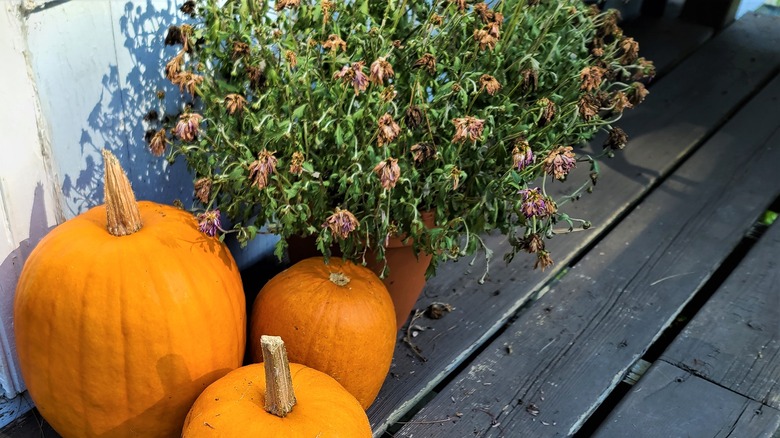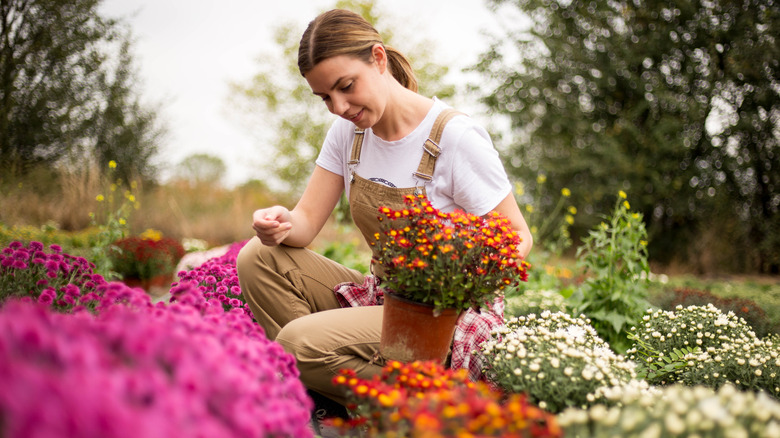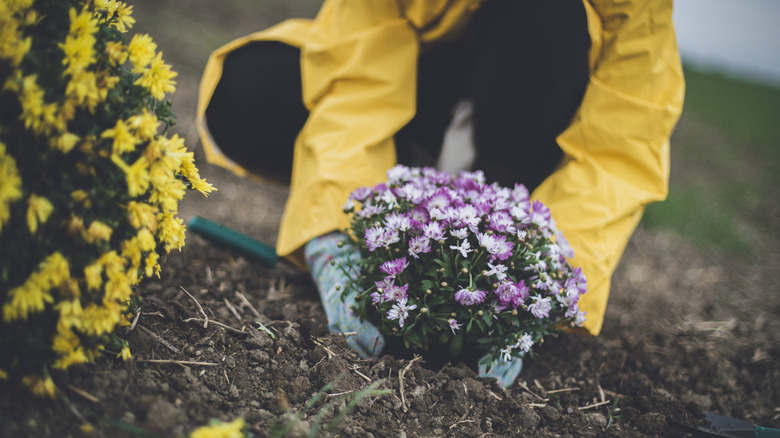Is It Really Possible To Grow Already-Dead Mums In Your Garden?
Once the fall weather rolls in, garden centers begin to put out potted mums, or chrysanthemums (Dendranthema or Chrysanthemum spp.), to usher in bright colors and prolong the growing season. Once the potted version starts to die off, you may not realize you can still plant these seemingly dead mums into the garden and continue their growth. Though some varieties are not necessarily perennials that will come back annually, they are likely to do well (and last longer) when planted.
Once your potted mums are done blooming, which often leads to the stems drying up and browning, you have a couple of options. You may be able to keep them alive if you put some time into them now and support their growth over the next season. Hardy mums are those that are perennials, which means you can pot them, give them a bit of a boost with nutrient intake, and watch them sprout up again in the spring months. Many hardy mums do well in USDA hardiness zones 5 to 9.
Many people purchase mums already in bloom because their colors are so lush, and they are pinched in the spring, which creates the rounded shape of these plants. This can make it harder to tell if your mums are actually still alive (you'll need to look deep into the plant's inner stems to see if they are still green). If so, you can plant the mums in your garden.
Give them a second chance first
Before you toss them out or try to transplant them, get the most out of fall mums by deadheading the summer blooms. Pinch off the top portion of each flower. When you notice brown spots happening, remove those bloom heads, and you may encourage new ones to grow. The plant no longer has to try to repair those dead blooms and can focus on new growth. If it's early enough in the season, you could see a significant amount development. You can also transport them to a larger pot with fresh soil to give them another boost of performance.
Once the plant is no longer blooming and becomes more browned, it's time to plant them in the garden. You can do this sooner, too, especially if you want to encourage them to come back annually. Let's assume you kept them potted through the fall. They look pretty dry and dead, but there's still some green at the base of the stems. At this point, you can pull the plant out of the pot, holding them at the base as you do.
It's tempting to chop off all of that dead, browned stem, but doing so isn't ideal. Instead, leave the dead components in place, as it will help to provide shelter and support for the living plant underneath. As long as you see some green at the base, chances are very good that you'll have new growth in the coming months once winter is over.
Give them the right environment for support
There are a few mistakes you'll want to avoid throughout this process. First, plant your mums where there's full or partial sun in most areas, though if you are in an area that's very hot into the winter months, partial shade is better. The more sun they get, the better they tend to bloom.
Next, make sure the soil itself is loose and moist but not overly saturated. As long as the soil isn't too clay-based or hard, you don't need to add any fertilizer or anything special to it. If you want to add nutrient support, choose a product that is high in phosphorus content, as that's going to support the root growth, allowing it to dig in during the cold months. Once you prep the plant in the spring and start to see some development, you can add a nitrogen-based fertilizer to it to encourage that new growth.
Once planted, make sure to keep the soil moist, especially over the coming months. The soil needs to drain well to encourage root growth and avoid mold or root rot. Also note that if you live in an area with snow, consider mulching around the base of the plant, adding an inch or so of straw, wood chips, or leaves around the plant. Avoid anything with chemicals in it (like stained or paint-colored mulch products). In the spring, be sure to trim back the dead material to encourage new branches to form.


